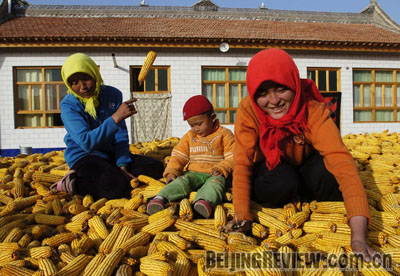|

BUMPER HARVEST: Migrants in Hongsipu Development Zone sit among
a corn harvest last fall, grown with water diverted from the Yellow Rive
A decade has slid away since Hongsipu Development Zone was first built to accommodate migrants from the poverty-stricken areas of Ningxia Hui Autonomous Region. The average yearly income of migrants soared nearly five fold to 2,300 yuan ($336) last year from a mere 500 yuan ($73) when they lived deep in the mountains.
Ecological migration is a policy adopted in 1999 by the regional government to relocate people from poverty-stricken areas to agricultural and urban areas.
Hongsipu, once a desolate area of 2,000 square km in the center of Ningxia, is the biggest ecological migration destination in the region. With financial aid from the Central Government, local authorities diverted water from the Yellow River and reclaimed the area as arable land.
People's gratitude
Gu Zhancheng, a 35-year-old Hui farmer, moved to Hongsipu last year from Tongxin County, a poor area suffering from severe shortage of water. "I felt grateful for the migration efforts of the government," Gu told Beijing Review.
Gu said before he moved to Hongsipu, he relied completely on nature to feed his family. "If the rain was enough, the grain could grow and we could eat. But most of the time, nature was not cooperative," Gu sighed in retrospect of his previous years.
Gu has an eight-year-old boy and a 10-year-old girl. "They now go to school. It was unimaginable when we lived in the mountains," said Gu.
His wife now works for a local company. "I take care of the farmlands, my wife works to earn extra money," added Gu.
According to Gu, his family grew 0.5 hectares of apples, 0.2 hectares of other economic plants and grains last year.
The government helped build his new four-bedroom house in Hongsipu, and he only had to pay for the decoration and furniture. "The government paid over 10,000 yuan ($1,464), and I spent about 20,000 yuan ($2,928)," Gu said. He used to live in a cave in the mountains.
With concerted efforts from the central and local governments as well as ordinary people, Hongsipu development has switched into full gear. Forest coverage in Hongsipu has reached 40 percent, and 2,000 hectares of land are now planted with grain.
To date, it received 200,000 migrants, the majority of whom are Hui people and from the poverty-stricken southern areas of the autonomous region.
| 